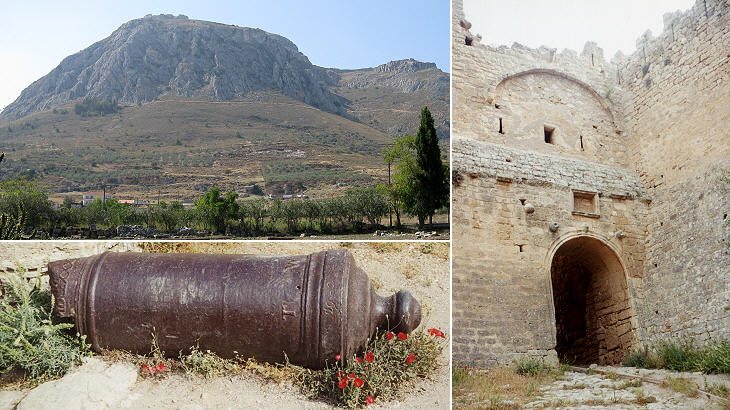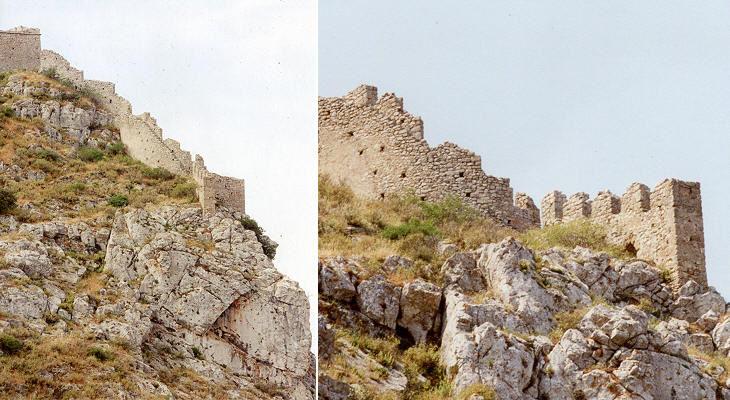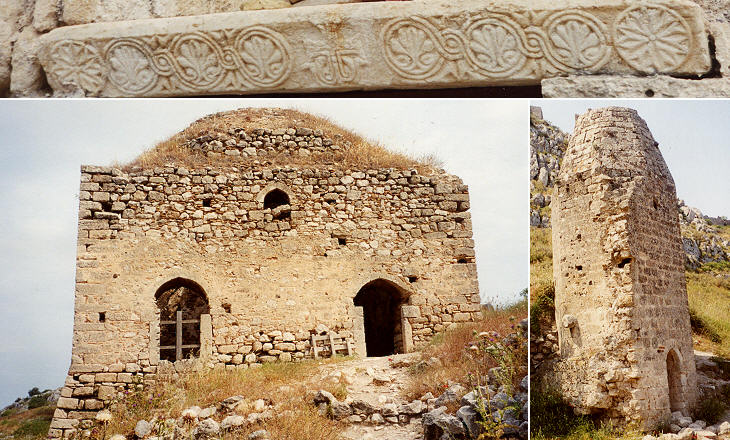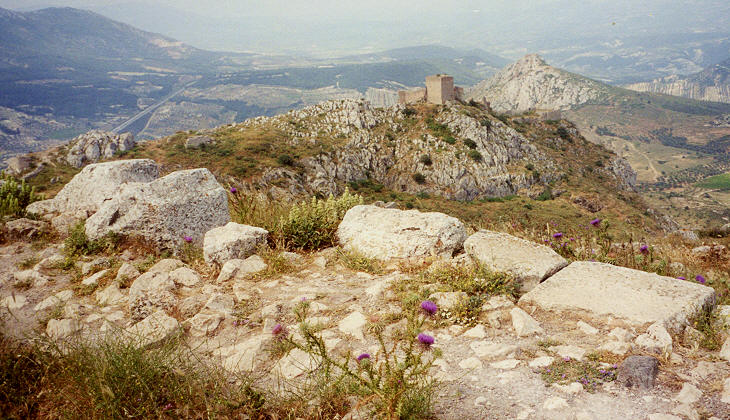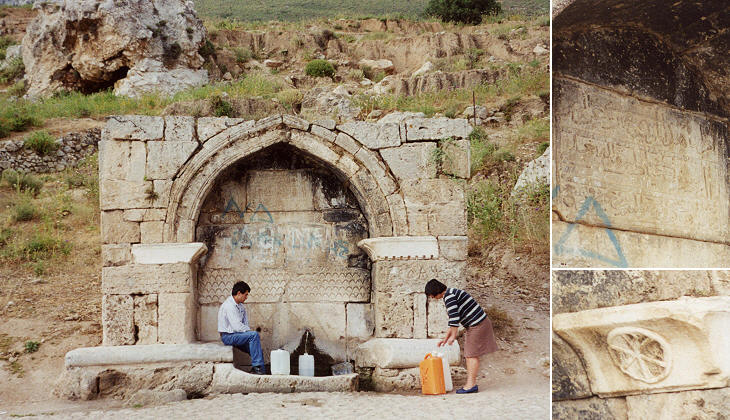

What's New!
Detailed Sitemap
All images © by Roberto Piperno, owner of the domain. Write to romapip@quipo.it. Text edited by Rosamie Moore.
Page added in 2002.
|

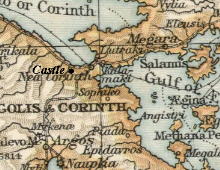 Corinto (Korinthos) Corinto (Korinthos)
Key dates of Ancient Corinth:
146 BC destroyed by the Romans
44 BC refounded by Julius Caesar
540 sacked by the Slavs
The ancient city of Corinth (in the background of this page the ruins of the Temple of Apollo), was
dominated by an isolated high hill, commanding an impressive view over the Istmus of Corinth.
Acrocorinth was always seen as holding the keys of Peloponnese and for this reason it was always a fortified place, although
Corinth itself was for many centuries a negligible village.
Byzantines, Franks, Venetians, Turks, again
Venetians and again Turks, they all built, destroyed and rebuilt walls and towers using the stones
of the ancient Acropolis.
In particular Venice during the second occupation of Corinth in the early
XVIIIth century protected the wide space at the top of the hill with three curtains of walls.
View of the hill. - One of the gates - A Venetian cannon
The walls were built taking advantage of the shape of the rocks which surround the top of the hill, leaving only one access
to the top from the west.
Walls of the fortress - western side
The garrisoners were not alone in the fortress, many civilians lived in what was a small town. The Greeks were allowed
to profess their religion, but only in a very silent way. The only evidence of a small building
being a church is a little frieze over the entrance. The two mosques for the Muslims were more prominent buildings. More than
1,500 Turks and other Muslims sought refuge in Acrocorinth in January 1822, when the Greeks of Peloponnese rebelled.
They eventually agreed to surrender to the rebels, provided that they could keep enough money
to hire neutral vessels for their journey to Asia Minor. But what followed was one of the many
massacres which have marred relationships between Greeks and Turks until today.
Frieze above the entrance of the church - Mosque and minaret
Acrocorinth has less sad religious memories. On the highest point of the hill a few lined stones are all that is left
of a paleochristian church erected to cancel the memory of the Temple to Aphrodite, which was devoted to hierogamy or sacred
prostitution. Apparently 1,000 (but having been to the site I can hardly believe this number
to be true) priestesses were ready to please the devouts. Their requests were however so high
that the Romans had a say Non licet omnibus adire Corinthum to explain that not everybody
could afford to pay for pleasing Aphrodite.
View from the Temple of Aphrodite
At the foot of Acrocorinth a fine fountain with both Greek and Turkish reliefs is still in use.
Fountain at the foot of Acrocorinth
Excerpts from Memorie Istoriografiche del
Regno della Morea
Riacquistato dall'armi
della Sereniss. Repubblica
di Venezia printed in Venice in 1692 and related to this page:
Corinto
Quasi nel mezzo all Istmo, ove s'affrontano i due Mari Ionio, e Egeo l'anno 3066 riportò da Alete al tempo di Cecrope Re d'Ateniesi i suoi Natali.
Corinto, detto da Strabone, e Polibio Corintus, da Lauremberg Ephyro, dal volgo Coranto,
da' Turchi Gerame, Città con titolo d'Archiepiscopale,
distante da Patrasso 80 miglia, d'Atene 50, da
Misitra 85, da Argos 25, soggetta ad Acrocorinto Castello, a cui è vicina; il sito ove posa,
considerabile per il vantaggio, apportò motivo, ch'alcuni la dicessero occhio e legatura della Grecia,
altri Fortezza del Peloponneso, che Plutarco la giudicasse
la più eccellente Città, e Cicerone la chiamasse la più bella e splendore della Grecia, e arrivò a tanta
grandezza che Siracusa, e Corfù si preggiavano d'esserli Colonie, e li Romani che pretesero
vendicare l'ingiure, che questa Città havea fatto a suoi Cittadini, inviò L. Mamio Console l'anno del Mondo
3818 ad abbassare la sua alteriggia con ordine spresso di spiantarla da fondamenti, e che
saccheggiata interamente, vendette all'incanto le Moglie, e Figlioli
de Cittadini; fu riedificata, e ripopolata da Cesare Augusto: eccedeva in nobiltà, abbondava
in ricchezze; hora però misero avanzo delle guerre, e del tempo, non conserva di suo, che le proprie rovine, quali servono di
tenue ricovero a pochi habitanti, mentre havendo doi volte servito di Teatro alle barbarie
d'Amurat II, e di Meemet suo figliuolo, che l'hanno totalmente desolata, c'hoggidì non contiene che venti case, che sono anco li
rottami dell'antiche: e d'altro non si vede d'intero
della sua magnificenza, che 12 Colonne di cinque piedi di diametro, e 20 incirca d'altezza, che per capitello
non hanno ch'un semplice cordone, quindici piedi una dall'altra, distant'incirca un miglio dal Mare sopra una collina
di figura anfitreale, i cui gradi scendono insensibilmente insin'al Porto Lecheo, e dove tutta via v'è una Torre, ch'altre volte
serviva di Fanale.
Abbracciarono questi la Fede Cattolica a persuasione delli Santi Apostoli Pietro, e Paolo, e furono in
questa confirmati l'anno 169 per opra di Dionigio secondo Vescovo di questa Città, nella quale perseverorono
fin'a che gl'Imperatori Greci si sottrarono dall'ubbidienza della santa fede.
Ruggiero il Normano Rè di Napoli l'invase, e avrebbe ben tosto coll'inestar il proprio scettro
negl'animi de Corintani, divertito in loro la rassegnata ubbidenza, che esseguivano giustamente i cenni d'Emanuele
Imperatore di Costantinopoli, quando nell'opportunità di farlo, accorsavi l' Armata Veneta, unita al Greco vinto,
non l'havesse dopo esterminato, costretto in fine alla fuga: Di gran conseguenza sono stati i danni inferti
al Rè combattuto, come importantissime furono le ricche spoglie lasciatevi dallo stesso sul Campo,
qual divise portorno gl'ausiliarij, perchè già redenta Corinto, non più bisognava il loro prode impiego: Non
corsero due secoli, che divenuta Vassalla de Despoti della Grecia, la cederono a Veneti, quasi che paresse a
que saggi Principi, esserne usurpatori, s'era meritato guiderdone à sì invitta Repubblica, che per ricuperarla
ad'un straniero, stancò il proprio braccio robusto; non erano sì giuste le reflessioni di Maometto Secondo,
ch'indiscreto Regnantesvelse da Corinto l'insegne di S. Marco, se ben sijno stati veementi i tentativi
per restituirle la dove furono rapite, non per questo sortirono profittevoli, perchè superati i Veneti di gran lunga
dalle barbare forze, connobbero espediente cessar l'impresa.
Re di Corinto
Anni del Mondo
2862 Atlete primo rè
2897 Trione
2934 Agilao
2971 Primina
3006 Baci
3041 Agela
3071 Eudemo
3096 Aristomede
3131 Egennone
3147 Alessandro
3172 Selesteo
3184 Ansomene
3185 Hebbe fine
Acrocorinto
Non merita Acrocorinto esser trascorso senza particolar distinzione, se ubligò una volta la fama a decantar
i suoi trionfi, cessati per altro in lui, perchè estinto da Marte, divorato dagl'anni. Questo
che contrastava a Corinto cui fu valida Rocca giacea alla cima d'erto, e acuto monte, sopra quale
v'era proportionato piano ben recinto di forte mura con entro accoppiato a molti pozzi di limpida,
e perfetta acqua il fonte di Pirene, mentovato da Omero nell'Odissea. Era per natura, e per arte molto fido,
e di gran forza il Castello, che d'ogn'intorno si rendea inaccessibile, salvo che dalla parte del Porto
Cenchreo; nulladimeno (perchè mal custodito) più volte superato, e in particolare da Siciliani,
sotto il comando di Niceforo Caluso ne tempi, ch'imperava Emanuele Comneno.
|
Introductory page on the Venetian Fortresses
Pages of this section:
On the Ionian Islands:
Corfù (Kerkyra)
Paxo (Paxi)
Santa Maura (Lefkadas)
Cefalonia (Kephallonia)
Asso (Assos)
Itaca (Ithaki)
Zante (Zachintos)
Cerigo (Kythera)
On the mainland:
Butrinto (Butrint)
Parga
Preveza and Azio (Aktion)
Vonizza (Vonitsa)
Lepanto (Nafpaktos)
Atene (Athens)
On Morea:
Castel di Morea (Rio), Castel di Rumelia (Antirio) and Patrasso (Patra)
Castel Tornese (Hlemoutsi) and Glarenza
Navarino (Pilo) and Calamata
Modon (Methoni)
Corone (Koroni)
Braccio di Maina, Zarnata, Passavà and Chielefà
Mistrà
Corinto (Korinthos)
Argo (Argos)
Napoli di Romania (Nafplio)
Malvasia (Monemvassia)
On the Aegean Sea:
Negroponte (Chalki)
Castelrosso (Karistos)
Oreo
Lemno (Limnos)
Schiatto (Skiathos)
Scopello (Skopelos)
Alonisso
Schiro (Skyros)
Andro (Andros)
Tino (Tinos)
Micono (Mykonos)
Siro (Syros)
Egina (Aegina)
Spezzia (Spetse)
Paris (Paros)
Antiparis (Andiparos)
Nasso (Naxos)
Serifo (Serifos)
Sifno (Syphnos)
Milo (Milos)
Argentiera (Kimolos)
Santorino (Thira)
Folegandro (Folegandros)
Stampalia (Astipalea)
Candia (Kriti)
You may refresh your knowledge of the history of Venice in the Levant by reading an abstract from
the History of Venice by Thomas Salmon, published in 1754. The Italian text is accompanied by an English summary.
Clickable Map of the Ionian and Aegean Seas with links to the Venetian fortresses and to other locations (opens in a separate window)
|



 Corinto (Korinthos)
Corinto (Korinthos)
